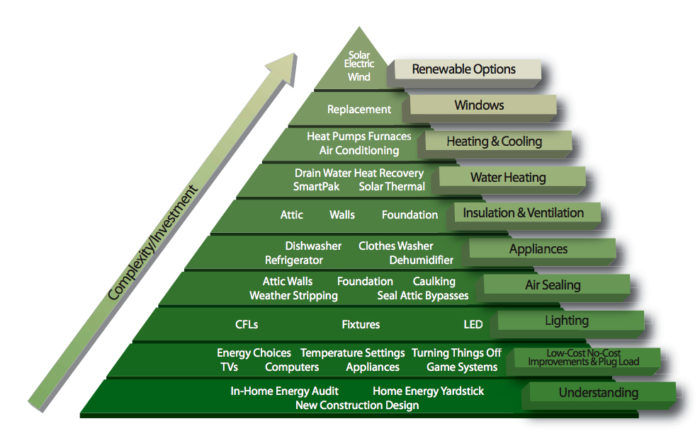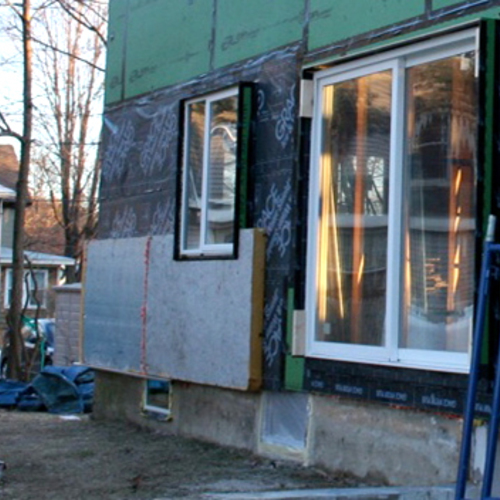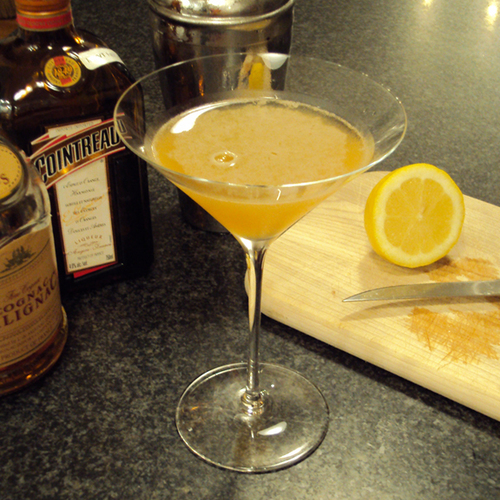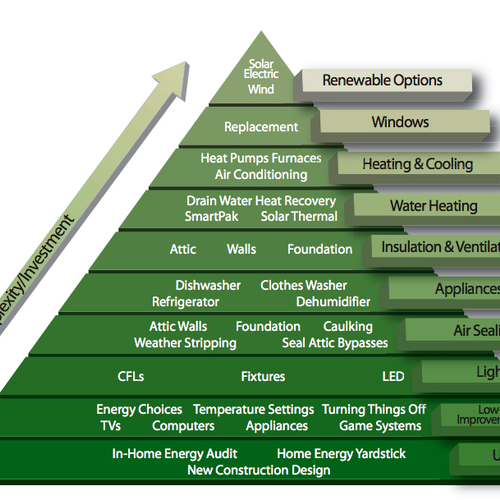
Image Credit: Minnesota Power
This is the last installment in the Green Architects’ Lounge trilogy on deep energy retrofits.
In this episode, Phil and I discuss the importance of sizing your new HVAC system to the heat load of your newly renovated house. (This is where that energy audit information, which we mentioned in previous episodes, is going to come in handy.)
During a break, Phil and I arm wrestle. Remember: This is a gentleman’s podcast, so wagering should be only among friends, and the stakes should be of a friendly nature relative to the subject matter—such as help with a home improvement project, or a bottle of 12-year-old single malt scotch.
To listen to GBA Radio on your iPod, right click on the green “Download .mp3” words above, save “Link” to your desktop, drag the file into iTunes, and enjoy the show whenever you want to! You can also subscribe directly from the GBA Radio on iTunes.
Then I have the pleasure—no, the honor—of reprising a previous GBA article, contributed by Martin Holladay, in which he provides us all with a simple guide to approaching a deep energy retrofit: The Energy-Efficiency Pyramid.
This fantastically simple graphic—the Energy Conservation Pyramid, created by Minnesota Power—is modeled after the “food pyramid.” The low-hanging fruit is on the bottom, offering you the greatest return on your investment; at the top, you’ll find features that represent the higher-hanging fruit, which should be considered only after you’ve worked your way up to them.
“The choice to be more energy efficient may be clear, but the starting point can be more difficult to determine. The Pyramid of Conservation is designed to help you prioritize steps and develop an action plan that’s right for you. By establishing a foundation in energy efficiency and gaining a better understanding about how you use energy, you can more effectively work your way up the pyramid.”-Minnesota Power-
Phil extends an invitation to our fellow New England listeners to submit their DER projects to be eligible for the Bright Built Retrofit Project He also informs us about the 1000 Home Challenge, and encourages us to be a part of the movement.
As always, we wrap up the episode with a song selection from Phil’s audio library. For this episode, he’s chosen “Quick Canal” by Atlas Sound, from their album “Logos.” It’s a great album for focused studio work! Thanks, Phil, and thank you, listeners. I’m going to put my elbow on ice.
Cheers!
OFFICIAL TRANSCRIPT
Phil Kaplan: So, HVAC… What happens to our HVAC?
Chris Briley: Well, again, the chances are very likely if were doing a deep energy retrofit, we’re already prepared to say goodbye to what’s down there in the basement…
Phil: The beast in the basement; say good-bye! Get rid of it.
Chris: Good-bye! Just hold a funeral for it. Now’s the time to really assess your goals, because if we’re going to have a real high-energy profile in this house, we’re going to have a much tighter house, a much more insulated house—maybe the whole distribution system of your house can be completely changed. Maybe we can gut out the dusty old ductwork with the asbestos tape around it and all that jazz, and we can just go to a couple little heaters, a couple little radiators somewhere. Or, reduce the ductwork and have just a couple fan coils—
P: Yeah, with a little heat pump…
C: Maybe a ductless minisplit system, which is really popular now. One of the goals that we had was to reduce the heat demand — the energy demand of this house so much. Here’s where you could actually recoup that cost: in downsizing the system to the appropriate level of your new design. And also, maybe there’s the ability to be greener—a more efficient system, a greener fuel…
P: Right. This is about electricity use, too; you’ll use a lot less power, running this huge…
C: Right. But maybe it’s not a beast. Maybe you don’t—this is where you want to have a professional involved—maybe you don’t have a giant oil boiler also heating up your on-demand hot water from that. Maybe we’ve got a whole new system.
P: And you have to be very careful when you talk to people who have never done these types of houses before. You hand it to a typical plumber, and they’re going to size it like a typical system. So that’s when you rely on your energy model, and you say, “Listen, I’ve got a peak heat load of this”—whatever it is—“and trust me, you’ve got to trust me, you can’t oversize this because you think it’s coming back to you and you’re going to get the call.” Because it’s a reasonable fear. They’re going to get the call—not the architect, but the guy who’s in charge of the heating system.
C: If they’re good, they’re going to do a Manual J; they’ll do a heat loss calculation (if we’re talking about heat, not air-conditioning). Anyway…
P: Heat pumps do both.
C: So that’s what they’re going to do. We’re going to have to leave it up to a different podcast to talk about the different systems and how you choose a system, but the idea here is: Downsize the system to the appropriate level.
P: Yeah, take that $40,000 that someone would want to spend on a system and say, “I only want to spend $15,000,” and put the rest of that money on the roof and on the walls, where it’s durable and it’s not going to break. It’ll last forever. Good investment. Good talk, Chris.
C: When we come back, maybe we’ll talk about Martin Holladay’s pyramid, because I love that graphic.
[break]
C: And we’re back everybody; thanks for hanging in there. I should also let you know that we can be found sometimes—we’re syndicated—on the Green Building Advisor. You can go to GreenBuildingAdvisor.com, after this airs, and join in the conversation, which is a great thing to do. Add your two cents. Tell us a great cocktail recipe, because it’s inevitable that we’ll run out at some point. We’ll go through my favorites…
P: I don’t know—Mr. Boston has a lot to say.
C: That is true. But if you discover the great one…
P: And give us some ideas for some future episodes. We do have some people chime in—
C: This is one, by the way.
P: And where do you find this on Green Building Advisor? Under Design Matters…
C: If you go to blogs, go to Design Matters, and we’re there. Sometimes, when they release it, we’re on the front page.
P: You can actually see what we look like. We’re so well suited to radio.
C: I love your photo. My photo—Kathy took it on my deck here. Your photo looks like it was professionally done.
P: That’s because I was 18 at the time.
C: Yeah, guys, he looks much older and fatter and balder now than he does in that picture.
P: That was right before my prom.
C: You kicked my butt arm wrestling.
P: For the record, we really did arm wrestle.
C: We did. We were curious when we signed off; should we do that? I was like, hell yeah, we should do that. That was the liquor talking, because, you trounced me, man.
P: Yeah, that was more fun than I thought.
C: ‘Cause you won! All right…
P: Take us to the pyramid. Is this different than the food pyramid?
C: That’s why it’s brilliant. I’ve done a lot of presentations where I work at going through this same process, and usually I’ve got dumb PowerPoint slides: “Start here,” and blah, blah, blah. But then Martin Holladay—if you’ve stumbled on the Green Building Advisor in any way, you know who he is. He had a great blog a while back with the energy efficiency pyramid. And I bet if you just put in their search bar “pyramid,” you’ll find this blog; it was an older entry. Anyway, he contributed this fantastic graphic that is after the food pyramid. It’s like bang for the buck. The stuff at the bottom, do first; and then you move up, and then you move up, and then you move up. At the bottom…
P: It’s fruits and vegetables, and grains. And at the top it’s steak.
C: Right. Filet mignon. Solar and wind at the top.
P: Solar / wind is the filet mignon, isn’t it?
C: I’ll go through it real quickly, because when you’re out there you’re thinking renovation; I’m going to do a green renovation. This is a fantastic way to think about it, and I give Martin all the props in the world for this wonderful graphic, which now replaces about four or five of my slides.
P: The thing that I love is that as you rise up the pyramid, complexity and investment increase.
C: Right. They’re together.
P: We can’t talk enough about costs. As architects, we’re going to have to start getting better and better and better about talking about numbers and money. We don’t like doing that.
C: We don’t. We hate money. Otherwise, we’d be spending it.
P: Right! We’d be doctors or lawyers if we liked money!
C: We need to be much better businessmen…we’d actually have profits…
P: Chris, hike up that pyramid with me; shall we go?
C: So, we start the bottom. You know what’s at the bottom? It’s not problem solving; it’s problem finding. It’s doing that energy audit. It’s getting the professionals involved. It’s analyzing what you’ve got. And we talked about that—that energy audit. Let’s move up to the next tier right away. This is all stuff that your dad told you: “Turn off that light! What, were you raised in a barn? Close that door! Are you trying to air-condition the whole neighborhood? Shut that door!” That’s what it’s all about. Look at your appliances. Do you have an old Amana refrigerator? Dude, get rid of that beast. I mean it. Get it out; recycle it somehow.
P: You can get a new avocado-colored refrigerator these days.
C: Exactly. It’s coming back. You can find avocado; don’t worry. And hey, don’t put it in the garage; don’t downcycle the fridge and say, “Oh, we’ll have extra storage in the basement!” Dude. You’re getting rid—I just said “dude” four times in the last minute.
P: Dude, that’s cool.
C: Those old beasts can suck amazing amounts of energy; just watch out. Anyway, what you’re looking at there is phantom loads. Put some things on some switches. And then we move up, and it’s almost the same thing: CFLs and light fixtures and LEDs; change out those lightbulbs. And then we get to the air sealing, and we’ve done a whole podcast, Phil, on air sealing; that was a good one. And that is basically—I’ll hit the stat: 25 percent of most energy loss is through convection through your exterior envelope. So, seal it up, people; that’s going to go a long way.
P: And sealing’s the first thing where you might have to do something; you might have to hire somebody. The other ones—really, you don’t. Well, except for the energy audit.
C: And then we’re into appliances. I guess that’s where the refrigerator is; I jumped the gun. It’s time to buy new appliances and get your energy load down. Then you get into insulation, as you move up. Our first podcast was on insulation, so go look us up on that.
P: We probably should do our first one over…
C: Whenever I go to iTunes, our first one is the most popular, and it makes me cringe every time. ‘Cause that means people were like, “Green Architects’ Lounge. That sounds like fun!” And then they listened to that long, long, long intro, and were like, “Get on with it guys! I don’t care why your podcast exists.”
P: Go…
C: And then here’s the fun thing: water heating. I’m really new to the drain-water heat recovery. That was one of those products where like, you know, when you take a shower, all the hot water that goes down the drain is going out…. So, you’ve got a plumbing fixture. And I was like, it has to run horizontal. Why vertical? It’ll just drop and be gone. No—water runs down; it clings to the side, which is how it works. And so that actually is a very effective thing. We’ll talk more about it later.
And then—we’re nearing the top and getting into windows. We’ve talked about windows, Phil. Oh, I skipped heating and cooling. You may have started off this retrofit with a massive, old steam boiler that used to run on coal and got converted to oil, and that thing is just a massive beast that probably should be moved to the bottom of this pyramid for you. But in most cases, it’s all the way up here. And then you’re up to windows. Windows are expensive and they’re tedious—and really, you’ve got to get it right.
P: Windows are hard.
C: Finally, you can do your solar and photovoltaic. Or your wind. All right, I’m done with the pyramid.
P: People say, I want to do an energy-efficient house; I’m going to look at solar.
C: Right, and you’re like, “Whoa, whoa, whoa, buddy!”
P: That’s at the top of the pyramid.
C: Look how far up we are. Start at the bottom; it’s not as fun or glamorous. We have to eat our vegetables. Before you eat your dessert, eat your rice. So, Phil, you start talking; I’m done.
P: All right. You know what I’d like to talk about?
C: What would you like to do, Phil?
P: I’d like to talk about BrightBuilt II.
C: Oh, yeah, let’s do. It’s a wonderful idea, and I’m behind it. Even though it’s not my idea. I wish it were my project, but it’s not; it’s yours. But it needs to get out there.
P: The point of this is that it is yours, Chris; it’s everyone’s. BrightBuilt II is going to be an open-source project, in the truest sense of the word.
C: And by that you mean…?
P: I mean that everyone has the ability to contribute their ideas. We genuinely listen to all ideas, and we have a blog going on. We’re going to set up a way to make sure that everyone is heard. So, let me back up a little bit. BrightBuilt Barn was a project that was completed in 2008. It’s a net-zero, LEED Platinum, replicable home that is modular—prefabricated, if you will (I’m not crazy about that word)—but you can actually purchase it and have it assembled on your site in three days.
C: How many square feet?
P: It’s under 800 square feet. It’s like a studio. But we have a one-bedroom, two-bedroom model. So, you, too, can have a net-zero home, affordably—under $200,000. This is a home run for us as a firm, and—
C: Even won an award…
P: It won an innovation award from LEED for Homes last year.
C: Now there’s BrightBuilt Barn II.
P: Yeah, we got this going because we realized a lot of people were very interested, and we decided to use what we got so far—this level of interest—and try to engage more people. So we’ve come up with a project called BrightBuilt II. And what it is, is a competition for a deep energy retrofit that we are going to partially fund and help you promote. It’s for a nonprofit organization.
C: So, if I’m a nonprofit…
P: You’re a nonprofit—and we’re limiting it. I apologize in advance, but we’re limiting it to New Hampshire, Maine, Massachusetts and Vermont. So if you’re out of those states, you’re out of luck right now, until we do BrightBuilt III.
C: I’m sorry, Helga, from Costa Rica.
P: We’re trying to focus this, because if we do it open source under conditions that are drastically different, we’re not really going to—
C: You’ve got to be careful about that.
P: We want to make sure what we’re doing is replicable. We want to engage as many people as possible. The call for submissions goes out May 1.
C: You are looking for clients.
P: We’re looking for clients! We’re looking for submissions. This is a competition. So, you submit your building, and you’re a nonprofit organization. If you go to BrightBuiltBarn.com, you’ll see a list. Right now, if you go, you’ll see the information for BrightBuilt Barn and what you need to submit. So, do it. We have a wonderful board of advisors who are going to help judge this project. We are going to have a short list by July 1. We’re going to have a project chosen by the end of August. And we are going to partially fund this and promote it. The goal is really to get out there what Chris and I have been talking about: deep energy retrofits. Really a moonshot. We’re trying to come up with an idea, with as many people as we can to contribute, and figure out the best way to do these things.
C: So, Phil, if you’re an architect already working with a nonprofit in the areas that you have outlined, and all of a sudden you’re listening to this, and you’re going, “Holy cow! The project I’m working on could qualify.” Submit?
P: Absolutely. Submit. Right on. We’d love it.
C: Awesome. Great work, by the way.
P: Stay tuned.
C: And we’ll keep you all posted on the results and how that all pans out.
P: Yep. Green Building Advisor is going to be somewhat involved. Martin Holladay is helping us out. He’s on the advisory board. Jim Newman from Environmental Building News is helping us out. Tedd Benson from Bensonwood… Tedd is a legend, really. As Hans Porschitz from Bensonwood calls him: the Pope of timber framing. I love that.
C: I’m not sure that’s a compliment these days…. Do you want to talk about Jesse? There might be a part two to this podcast. If you’re familiar with this podcast, you’re familiar with Jesse, the grumpy architect that we keep in the basement. The reason why he hasn’t been around lately is because he’s spending time doing a deep energy retrofit on his own house that he purchased in Portland, Maine.
And so this podcast is probably going to have a part two—maybe right away, or maybe later. Whenever we can unshackle Jesse from whatever he’s shackled himself to. It’ll sort of be a whole hour of what’s bothering Jesse, but pertinent to this very topic. I think we’ll all learn a lot as he goes through the lessons he’s learned, if he’s honest—which he will be. He’s always brutally, brutally honest.
P: It’ll be really enlightening.
C: I’m looking forward to it. I can’t wait to actually do that.
P: I’ve got one more thing today that I want to talk about, which I did not mention. LEED for Homes is a good program. They don’t have anything that’s great for retrofits. They have the ReGreen program, which, honestly—for such a powerful organization, it’s kind of weak. I’d love for them to step it up a couple of notches.
I think the strongest thing out there now is called the Thousand Home Challenge. It’s the Affordable Comfort Institute; I think it’s ACI.com, probably. It’s the first real program that tries to track deep energy retrofits across the country. We’ve got a project now that’s entered into it. There’s another project in Freeport that Peter Warren and Peter Troast—you know Peter Troast? Energy Circle?
C: I’ve heard of it. I don’t know him.
P: Good guys. They’re doing the Thousand Home Challenge. Go to EnergyCircle.com; it’s a great Web site. So, I really recommend going to the Thousand Home Challenge, and if you’re doing something similar, check out that Web site. They’re doing good things and trying to spread the word as well.
C: Is there anything else you want to talk about?
P: So many things. But we’ll be back.
C: We’ll be back later.
P: I’d love to tell you about my song.
C: Well, tell me about it. In fact, we’ll cue it up while you’re talking about it.
P: Yeah, cue it up. It’s got this nice lead-in. The band is called Atlas Sound.
C: I’ve heard of them.
P: Yeah, you know, I usually do albums that are current, immediate—
C: Yes. Which we love you for.
P: Thank you. This one’s from last year, and I discovered it late, so I’m playing it.
C: You discovered it late?
P: I heard about it, but was like, I’ll get around to it. Bradford Cox is the lead singer of Deerhunter. This is another band of his. I thought that Deerhunter was OK. I went to see them with Spoon in Boston a couple of weeks ago. This album is just beautiful stuff. It’s very different. It’s softer than the Deerhunter stuff.
C: I’m going to love this in the studio.
P: I think you will. A lot of it reminds me of the more ethereal… Cocteau Twins, Pale Saints. I’m dating myself. The name of the song is Quick Canal by Atlas Sound. Enjoy. Chris, it’s been a pleasure. Green Architects’ Lounge. Deep energy retrofits. Let’s do it again soon.
C: You got it.
Weekly Newsletter
Get building science and energy efficiency advice, plus special offers, in your inbox.














5 Comments
Listened to podcast
It was well worth talking about the energy pyramid in your podcast I thought. It occurs to me, that when you talk to homeowners about energy retrofits, they struggle a lot to understand which sequence in which to plan their energy reduction measures. You are right of course about that old fridge. As there are conflicting values at work here - on the one hand, the idea of not dumping anything and wasting - and on the other hand, the real picture, that the old appliance was so inefficient.
We are getting out of the habit of using 'open fires' here in Ireland - and moving towards solid fuel stoves, which burn timber etc much more efficiently, and give out much better heat. But we have been wedded to the notion of roaring fires in winter, in such a damp, moist climate as Ireland, that we find it hard to get away from the habit. In the older housing stock, the open fire was part of the maintenance of the building, in that it purposefully drew air in through the structure and kept the house 'aired'. In other words it was a very inefficient heating system, but it was drawing moist, stale air away from parts of the house where it would otherwise condense and begin to decay.
Recently, an old lady asked me to recommend improvements she could make to her house. Out of curiosity I had a look around. I knew it was a mistake to even bother to make suggestions - as I knew she would have a stock answer for anything I said, to put me back in my place. I suggested that her attic hatch was un-insulated and had ventilation holes in it. She was losing lots of heat through this area. But I was told that was on purpose, to ensure her water pipes in the attic didn't freeze in the winter. In otherwords, a lot bit of inefficiency was being tolerated, and higher fuel bills over an extended period - in order to avoid, a large capital exposure at one time - in having to deal with frozen water system. It wasn't the answer I had expected, but it was interesting nonetheless. It made me realise the importance of getting a full 'history' of the patient. As a diagnostic doctor would have to do in a hospital. Automatically, I would advise a lady like that to insulate at rafter level, for ease and simplicity and forget totally about here water system. Sure, it would take more expense and effort to do insulation at rafter level, but it would have the advantage of keeping the water system on the warm side of the insulation, rather than the cold side.
There were other things I suggested too, she could change in her house - sinced she asked my opinion - but needless to say, I would put in my place, on every single count. It was a valuable learning experience for myself nonetheless, because it gave me a better understanding of that old house - and most importantly, how people manage the residence, as they live in it, throughout their life time.
At some stage, as architects, we will have to reflect differently on retrofits - and step back from the 'gung ho' factor of going in with the insulation and the vapour control layers etc - and get back to that idea, that people spend their lives in these structures - and have adapted in all kinds of weird ways, to enable themselves to attain comfort and relative safety from disruptions. What the bulk of the market out there, doesn't not need, is an architect or an energy pyramid - but what they need is a whole life coach, to enable them to accept a different approach. An architect can only be a designer at the end of the day - and cannot step over the boundary and become a person's life coach. There is no payment for that.
Note on transcripts:
The transcript above is quite handy too, because if you miss a detail or reference in the podcast, you can easily check it from the transcript above later. You always drop names of different individuals doing other work and other projects etc, and it is useful to be able to find those references again in the transcript. Most podcasts, are just that, a podcast. I tend to listen to a podcast on the move on the mp3 player - and I forget to follow up on references in the audio version.
Correction
Above should read:
I would advise a lady like that to insulate at CEILING level, for ease and simplicity and forget totally about here water system. Sure, it would take more expense and effort to do insulation at rafter level, but it would have the advantage of keeping the water system on the warm side of the insulation, rather than the cold side.
Human Behavior
Thanks Brian. Your "comment" is like a little article itself. The best we can do sometimes is educate those seeking our advice. I myself, quickly loose patience with those who seek my help but then seem to not want it. It happens rarely, but in a fashion like you stated above. There's always the stock speech about human behavior. An energy star appliance is still an energy hog if you leave it on all day, and your R-21 batt insulation is useless when removed from a section of the attic and piled up in a heap in one spot.
Coincidently, our next podcast is on Biomass boilers (a newer concept on this side of the pond)
Cheers
Giving advice
Kevin Roche of Roche Dinkeloo told a very good story the last time he was here in Dublin. He was a young student in the 1940s, and was walking through the city centre one day, when he saw a traffic accident. A police man was pacing out the distances to record in his notebook, of the cars on the street. Kevin quickly spotted an opportunity to make himself useful, and went over to the policeman and said, I could be of help, I'm an architect. The police man turned to the young student, looking very annoyed at being distracted while pacing out the distances - and said something to the young architect, I had better not repeat. Kevin Roche said, it was the last time he ever offered his services for free.
I think it was a great story, and contains a very true lesson - for architects in general - but especially where retrofits and pyramids are concerned.
Just a comment on reusing old refrigerators. I agree with the energy efficiency argument, and that they shouldn't be re-used for things like a beer fridge.
I have used my old refrigerators (unplugged, of course) as storage cabinets in my unheated and leaky garage. They are pretty much rodent proof and insulated, so I keep things that mice like (shop towels, gloves, etc), and stuff I don't want to freeze (I put a small light bulb inside if it is going to get too cold), and it has worked well for years. I think the re-use is a good option, but there may be downsides I haven't considered.
Any thoughts on this? I would like to hear what others think.
Log in or create an account to post a comment.
Sign up Log in